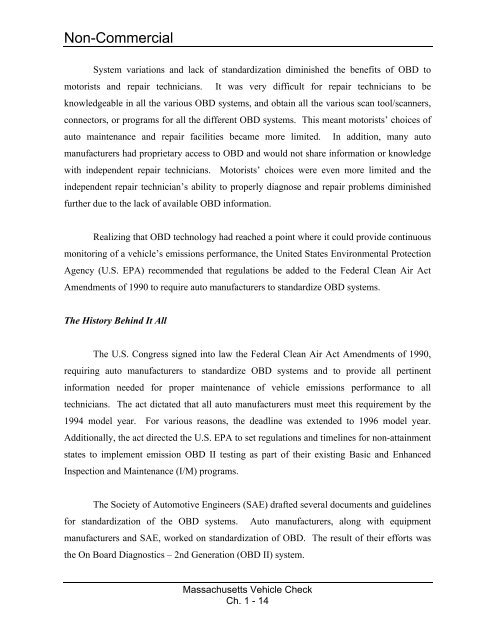Massachusetts Vehicle Check - Mass08 Management Module ...
Massachusetts Vehicle Check - Mass08 Management Module ...
Massachusetts Vehicle Check - Mass08 Management Module ...
Create successful ePaper yourself
Turn your PDF publications into a flip-book with our unique Google optimized e-Paper software.
Non-Commercial<br />
System variations and lack of standardization diminished the benefits of OBD to<br />
motorists and repair technicians. It was very difficult for repair technicians to be<br />
knowledgeable in all the various OBD systems, and obtain all the various scan tool/scanners,<br />
connectors, or programs for all the different OBD systems. This meant motorists’ choices of<br />
auto maintenance and repair facilities became more limited. In addition, many auto<br />
manufacturers had proprietary access to OBD and would not share information or knowledge<br />
with independent repair technicians. Motorists’ choices were even more limited and the<br />
independent repair technician’s ability to properly diagnose and repair problems diminished<br />
further due to the lack of available OBD information.<br />
Realizing that OBD technology had reached a point where it could provide continuous<br />
monitoring of a vehicle’s emissions performance, the United States Environmental Protection<br />
Agency (U.S. EPA) recommended that regulations be added to the Federal Clean Air Act<br />
Amendments of 1990 to require auto manufacturers to standardize OBD systems.<br />
The History Behind It All<br />
The U.S. Congress signed into law the Federal Clean Air Act Amendments of 1990,<br />
requiring auto manufacturers to standardize OBD systems and to provide all pertinent<br />
information needed for proper maintenance of vehicle emissions performance to all<br />
technicians. The act dictated that all auto manufacturers must meet this requirement by the<br />
1994 model year. For various reasons, the deadline was extended to 1996 model year.<br />
Additionally, the act directed the U.S. EPA to set regulations and timelines for non-attainment<br />
states to implement emission OBD II testing as part of their existing Basic and Enhanced<br />
Inspection and Maintenance (I/M) programs.<br />
The Society of Automotive Engineers (SAE) drafted several documents and guidelines<br />
for standardization of the OBD systems. Auto manufacturers, along with equipment<br />
manufacturers and SAE, worked on standardization of OBD. The result of their efforts was<br />
the On Board Diagnostics – 2nd Generation (OBD II) system.<br />
<strong>Massachusetts</strong> <strong>Vehicle</strong> <strong>Check</strong><br />
Ch. 1 - 14


